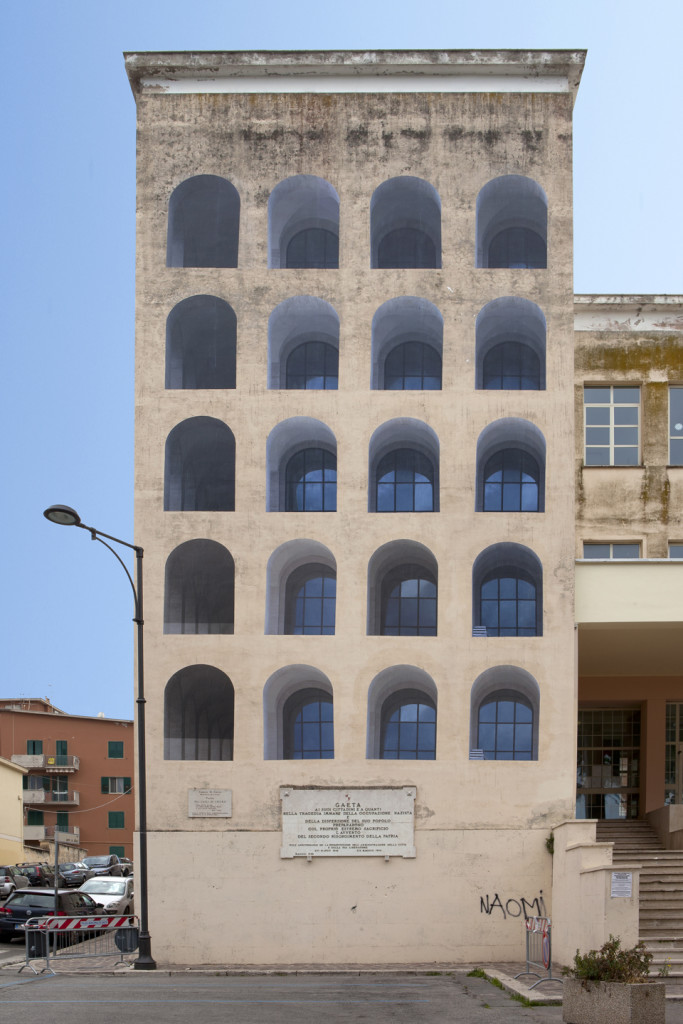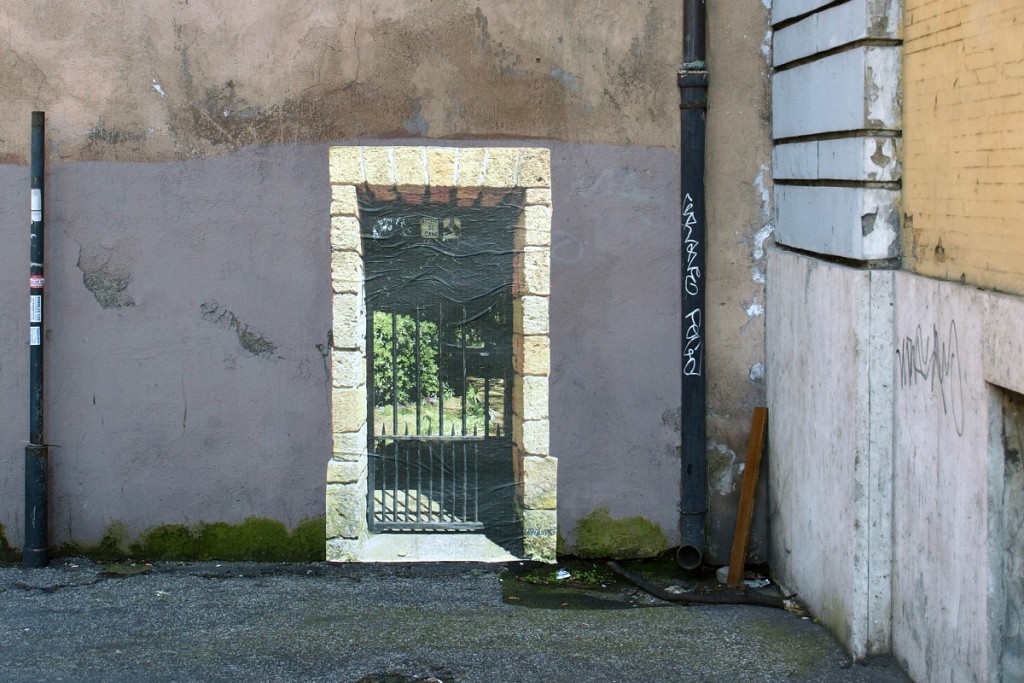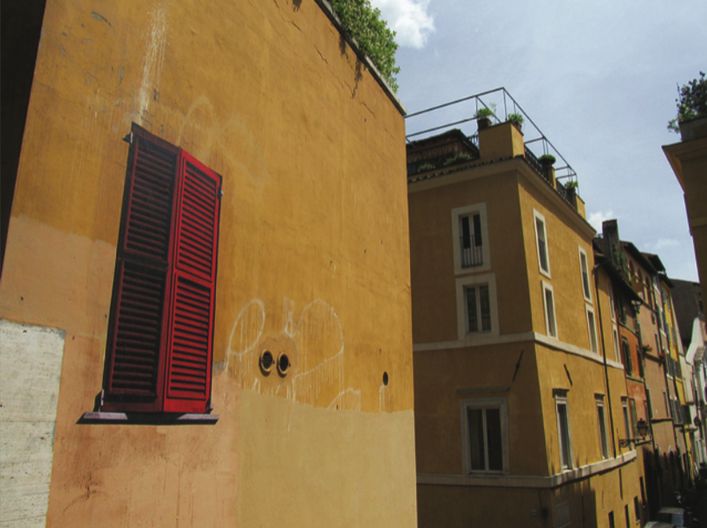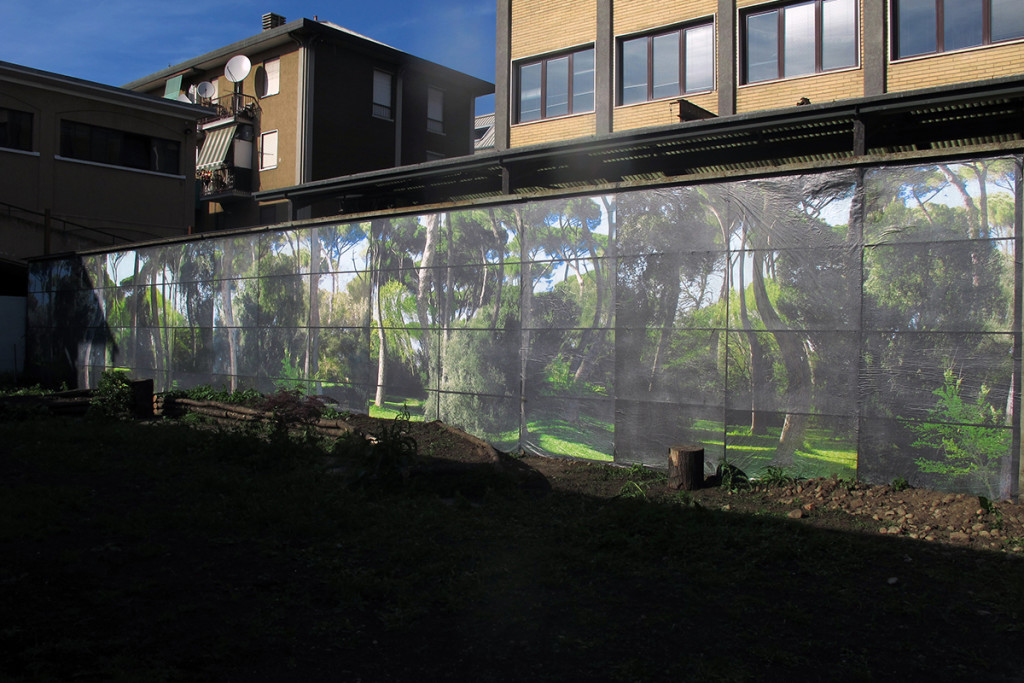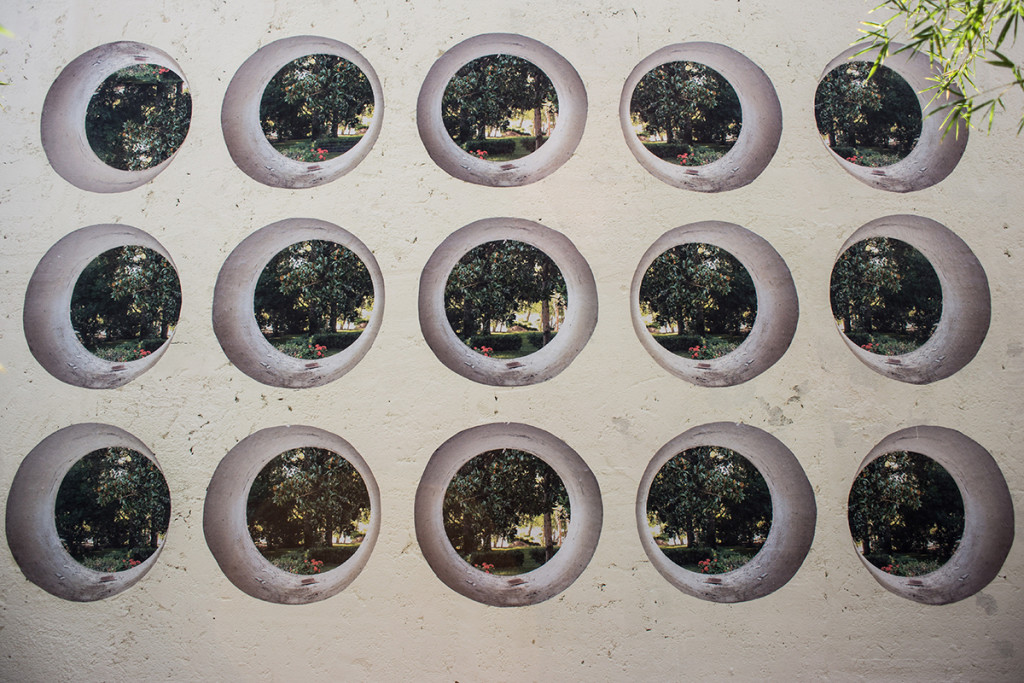Quante volte quello che vediamo non è poi realmente ciò che sembra?
La vista è un senso molto acuto, gli occhi organi affinati, ma basta poco affinché vengano tratti in inganno e trascinati nell’illusione. Generare questo tipo di sensazioni disorientando le nostre facoltà percettive è l’esito che si è proposto SBAGLIATO, un collettivo artistico romano che attraverso l’affissione di posters riproducenti elementi architettonici, crea dei trompe-l’œil dalla straordinaria modernità che spiazzano lo spettatore rompendo il normale equilibrio con cui ci troviamo costantemente a contatto.
«Appena ci siamo conosciuti si è innescata una forte sinergia. Gli intenti erano di muoverci nel tessuto urbano provando a rafforzare il nostro forte legame con la città dove siamo nati. Quello che abbiamo iniziato a fare è prendere ciò che avevamo intorno a noi. Un gesto semplice ma di forte impatto.», con queste parole iniziano a raccontarmi la loro esperienza che affonda le proprie radici diversi anni fa a Roma. Anche il nome che hanno scelto di adottare è di per se molto d’impatto ed esplicativo, non ha solo un’accezione morale ma racchiude in se una vera e propria modalità espressiva: «Il gesto di attaccare illegalmente dei manifesti, qualunque sia il soggetto, porta con se un significato: il voler mostrare qualcosa al di fuori dei normali canali di comunicazione. Quindi a prescindere dal nome che abbiamo adottato si può dire che quello che facciamo per certi versi ha una valenza morale dovuta prevalentemente al nostro modo di comunicare.»
Nei posters di SBAGLIATO tre tasselli essenziali si uniscono al fine di creare l’opera stessa: architettura, grafica e fotografia generano una sinergia che ha come intento quello di «dare sempre un equilibrio a queste tre componenti.», che non sempre però viaggiano di pari passo in quanto «alle volte può succedere che una di queste sia presente con maggiore forza, ma sempre con lo scopo di comunicare nel miglior modo possibile il lavoro.»
«Creare domande nell’osservatore è sempre importante per noi. Questo lo facciamo andando a stravolgere lo spazio.» Porte che aprono sul vuoto o finestre che si spalancano nel cemento sono infatti tutti elementi che fanno sorgere interrogativi all’interno di colui che le guarda, lo costringono a fermarsi per qualche minuto e strizzare gli occhi per capire se quello che ha davanti è reale o solo frutto della sua immaginazione. Le domande che si pone sono molteplici: «gli interrogativi sono diversi. Noi diamo sempre una personale visione di ogni lavoro che facciamo, ma rimane strettamente personale. Ogni volta vediamo che le persone deducono delle proprie osservazioni, delle proprie sensazioni. Crediamo che sia dovuto al discorso iniziale, ovvero dello stravolgere. Utilizzando questo metodo non ci aspettiamo che il messaggio sia unico e in realtà non lo vogliamo neanche. Creare una confusione con fini costruttivi ci interessa maggiormente.»
Le produzioni che creano s’infiltrano silenziosamente nel tessuto urbano generando però di conseguenza una frattura nell’ordine architettonico, si appropriano dello spazio cambiandone aspetto e modificandolo a loro piacimento, ma l’assetto urbanistico resta ancora lontano dalle loro intenzioni: «Solitamente abbiamo lavorato su scale minori, non grandi quanto potrebbero essere quelle urbanistiche. Non ci sembra appropriato metterci in relazione con un discorso urbanistico ma è anche vero che non è mai capitata l’occasione per poterne cominciare a parlare.». Sono opere che se da un lato tendono ad una valenza urbanistica, diventando parte della trama architettonica, dall’altro richiamano all’attenti lo spettatore, che come diceva Duchamp deve fare l’opera d’arte: «Il progetto nasce da un’esigenza precisa, quella di interagire con il tessuto urbano e dialogare con esso. Alla base del nostro lavoro è presente la città perché prendiamo elementi da essa e li riproponiamo in formula trasversale. Per questo è innata una valenza urbana, ma per quanto riguarda l’osservatore, la street art da quando esiste ha sempre avuto una predisposizione a dare risposte. Quello che vogliamo fare noi è proprio il contrario: ossia generare domande e far interrogare il fruitore su quanto sia relativa la realtà in cui viviamo.»
Tra tutti gli elementi architettonici che SBAGLIATO utilizza, sicuramente le finestre sono quelli che ricorrono con maggiore frequenza, questo perché: «È il soggetto da dove è iniziato tutto. Forse anche il più eloquente poiché può far percepire al fruitore un luogo adimensionale: neutro.». Ma non sempre il collettivo ha utilizzato questo tipo di componenti, come dimostra un intervento molto interessante realizzato in occasione della collettiva “Muovere le acque” a Milano: “Fototropismo”, che si distacca dalla precedente produzione per il carattere prettamente naturalistico: «Fototropismo è una continuazione di un esperimento iniziato nel 2011 ad Arcidosso in occasione del “Alterazioni Festival”. In quell’occasione abbiamo campionato una superficie vetrata/specchiata che consentisse la riflessione ottica di un contenuto completamente estraneo alla superficie interessata, con il duplice intento di aggiungere da una parte una realtà inesistente, dall’altra usare il vetro come strumento di sottrazione.»
Dopo tutta questa lunga chiacchierata mi viene in mente una citazione dell’architetto Ludwig Mies van der Rohe che recita: “Nella sua forma più semplice l’architettura è ancorata a considerazione assolutamente funzionali, ma può ascendere attraverso tutti i livelli di considerazione fino alla più alta sfera di esistenza spirituale, nel regno della pura arte”, che secondo me può adattarsi all’operato di questo gruppo per la loro concezione estetica legata all’architettura e più in particolare al dettaglio architettonico. Loro mi rispondono che: «Si, ci possiamo rispecchiare in quello che dice Van der Rohe ma con le dovute precauzioni: la nostra fortuna è quella che possiamo giocare con l’architettura. Senza compromessi. Possiamo modellarla come un architetto potrebbe fare solo nei suoi sogni o nei suoi incubi.», sogni ed incubi che creano una dicotomia tra l’occhio che capta ciò che vede come normale e la mente che avverte la presenza di qualcosa di SBAGLIATO.
[divider]ENGLISH VERSION[/divider]
How many times what we see is not really what it seems to be? Sight is a very acute sense; eyes are perfect organs but it doesn’t take much, and they are misled, drawn into illusion. This is the purpose of SBAGLIATO [it. ‘wrong’ NdT], a Roman artistic collective, in creating this kind of sensations; confusing our perceptual discretions. Towards the billposting of posters reproducing architectural subjects, they create extraordinary modern trompe-l’œil, which surprise the public breaking the natural balance between us and what we are always in touch with.
“As soon as we met, a strong synergy activated. We meant to move towards the urban context, trying to make our relationship with the city we were born in, stronger. What we started with, was taking all we have around us. A simple, but sharp action.” – That’s how they started to tell me about their experience, which has had its roots in Rome a few years ago. The name they chose has high impact and it is very explicative: not only has a moral meaning, but a real expressive reality too: “The action of billposting illegally, whatever the subject is, has a meaning: the will to show something beyond the normal ways of communication. So, apart from the name we adopted, we can say that in a certain way, what we do has a moral worth mainly due to how we communicate.”
In SBAGLIATO’s posters there are three essential elements that mix, in order to create the work: architecture, graphics and photography generate a synergy that means “to give balance to these three parts”. However, they don’t always go at the same speed, because sometimes “the presence of one of these is stronger, but only in order to express the job in the best way.”
“It’s always important for us to make the observer wonder. And we do it upsetting the space”. Doors opening on the vacuum or windows opening on the bond are things that create questions in a person who watch them; they stop him for a few minutes, and they squint to understand if what they have in front of them is real or just a result of their imagination. And there are a lot of questions: “There are different doubts. We always offer a personal view of every work we do, but it is strictly personal. Every time we see people making their own observations, feeling their own sensations. We believe it is due to the opening matter: the upsetting. Acting this way, we don’t expect the message to be unique and we don’t want this, actually. We’re more interested in making a mess on productive purpose.”
Their creations quietly penetrate into the urban background, giving life to a consequent rift in the architecture order; they take control of the space, changing its appearance as needed, but the city structure doesn’t reproduce their intentions, yet: “We used to work on smaller scales, surely not big as the urban ones. It doesn’t seem appropriate to deal with the urban issue, but it’s true we didn’t even have the chance to talk about it so far.”
We’re talking about works that, on one hand, have a urban value becoming part of the architectural structure; on the other hand, they attract the attention of the spectator, who has to do the work of art himself, like Duchamp said: “The project comes alive thanks to a clear idea, the one of interacting with the city background and talking to it. The city is at the bottom of our job, because we take basics from it and we reproduce them in a crossway. So, the urban value is innate but, regarding the observer, street art has always been ready to give answers. What we want to do is exactly the opposite: generating questions, with the user questioning about the relativity of the reality we live in.”
Among the architectural instruments used by SBAGLIATO, windows are certainly the ones that recur more because, “It’s where everything has started. Maybe it’s the more eloquent, it lets the user perceive a non-dimensional place: something neutral.” However, the collective hasn’t always used this type of elements, as a very interesting participation shows during the collective exhibit “Moving the waters” in Milan: “Phototropism”, that detaches itself from the previous production for the typically naturalistic features. “Phototropism is the continuation of an experiment that started in 2011 in Arcidosso, during the “Alterazioni Festival”. On that occasion we took a sample of a glass/mirrored surface so that it made possible the optical reflection of a completely extraneous object to that surface, on the double purpose of adding a non-existing reality on one side, using the glass as an instrument of subtraction, on the other.”
After this long conversation, a quote of the architect Ludwig Mies van der Rohe comes to my mind: “Architecture is in the simplest form, anchored to absolutely functional consideration, but it can ascend through all the levels of consideration ‘till the higher sphere of spiritual existence, in the kingdom of the pure art”, that in my opinion can be adapted to the work of this group, because of their aesthetic concept connected to architecture and, in particular way, to the architectural detail. And their answer is: “Yes, we can find ourselves in what Mies said, but with due caution: we’re lucky, because we can play with architecture. No compromises. We can shape it like an architect could ever do only in his dreams, or nightmares”. Dreams and nightmares that create a division between the eye, and what it receives as normal, and the mind, that feels there’s something WRONG.
Traduzione a cura di Silvia Cascioli





